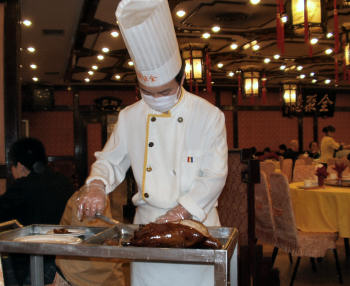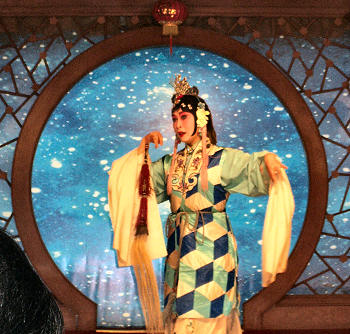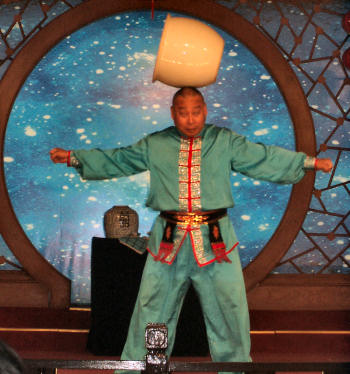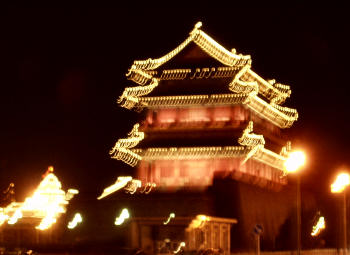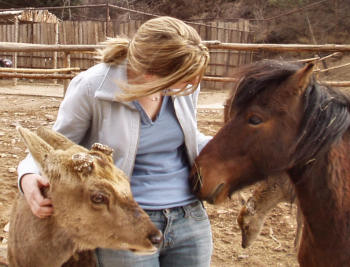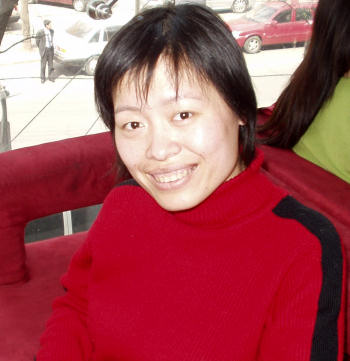This series of reports was generated in an unusual fashion. Almira Skripchenko
has a very tight schedule, travelling all around the world to play in strong
women's tournaments. Since the pictures she brought back from her trip to China
were so numerous and the stories so interesting, we decided to do the reports
with her in sections, from different parts of the world, using the Internet
and the good old telephone. Almira selected the pictures and mailed them to
us. Then, in long phone conversations she described her trip and the
pictures she had sent. We recorded and transcribed these conversations, sticking
as close to her original diction and narrative flow as we could. To give you
an impression of what she sounds like, here is a short segment from one of
our recordings:
Discovering China
By Almira Skripchenko
In February I received an email from [former World Women’s Champion]
Xie Jun. She asked me if I would be interested to go to China to play in a
women’s tournament, which ChessBase has covered already (see links below).
But apart from that they wanted me to take part in the Chinese National Team
League, which was being organised for the first time in China. I was a bit
worried, because I understood that I would have to spend something like one
and a half months in China. But in the end curiosity won, and I decided to
do it.
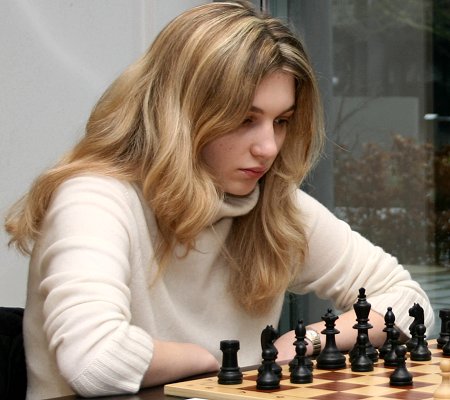
Almira Skripchenko, former European and current French women's champion
The National Team League is like the German Bundesliga, but they have more
teams, nineteen in all. I was part of one of the teams from the Shandong province,
one of three Europeans. The rest were Chinese players. I was playing on the
first women’s board. Each team has three men’s and two women’s
boards. As you may know in China women’s chess is quite important, maybe
even more important than men’s chess.
Apart from this we were working a lot on promoting chess. We had a lot of
meetings with the sponsors, gave interviews, to television, radio stations.
You know, people even started to recognise me on the street in Beijing! Also
as part of our promotion we – Xie Jun and I – played a match in
AIGO Chess, which is something created by the sponsor. It is like
normal chess, but they introduced an additional piece called the cannon, which
was placed on b2 and g2, with the pawns starting on b3 and g3. But that is
part of report three.
Beijing
Okay, chronologically: first I arrived in Beijing and started to discover
China. Even before this trip I was really fascinated by the country, and this
was an incredible opportunity to learn more, to visit many cities – I
was running around like a tourist, with a huge travel guide, reading about
every city I visited, even learning a little Chinese. But during this trip
for me it was a wonderful opportunity not only to make friends with Chinese
players, but also to understand the way they play chess and how they train.
Normally you only meet them at official tournaments, where there is a Chinese
squad playing for their country and showing no emotions. During this tournament,
in their country, they were wonderful human beings. Also they gave me an insight
into their chess training methods – so maybe I can do better against
them next time.
So let us come to the pictures.
This is the first picture I took in China, of a chef who was dressed like
a surgeon doing a duck. It was my first evening in the country. I was quite
tired and jet lagged, and I decided to go to a restaurant which served Peking
Duck, which is a famous Chinese dish in Paris. The chef came with his knife,
showed us the duck and cut it up in front of us. It was quite a shock for me,
but the food was very delicious.
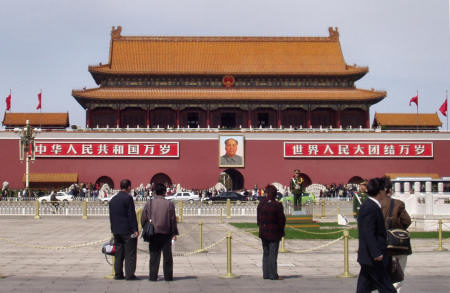
The next day I went to the Forbidden City, also known as the Imperial Palace
Museum or Gugong. It was the place where the emperors of the Ming and Qing
Dynasties resided and ruled. The above picture is taken from Tian'anmen Square,
and the Forbidden City is behind the red wall.
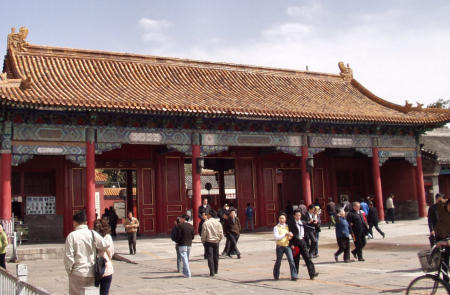
Now people can see the great traditional palace architecture and the treasures
of the palace, and they can learn of the stories and legends about the imperial
family and the Chinese court.

Inside the Forbidden City, which is full of visitors from China and all over
the world.
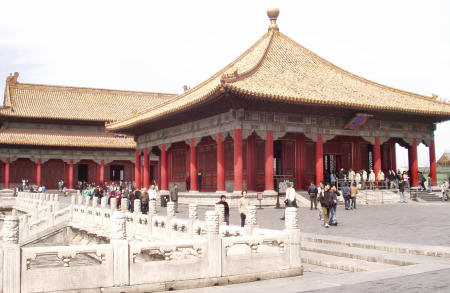
It is quite incredible walking around and seeing these beautiful ancient structures.
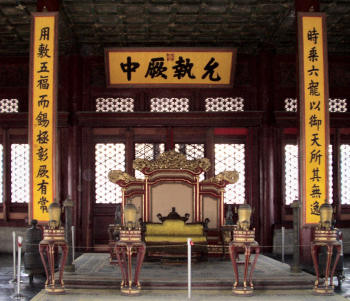
One of the emperor’s chambers.
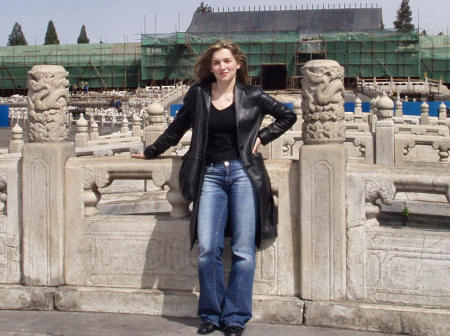
This is me inside the Forbidden City, really inside, at the point where historically
the beheadings took place. When the Chinese emperors lived here they had something
like 10,000 eunuchs protecting them. They had many wives and lived in a corner
of the city. There was some point you were not allowed to pass. If you did,
they would cut your head off, which was why it got the name Forbidden City.
Today the entire complex is being restored. You can see it from the buildings
in the background, which are covered and scaffolded.
After the Forbidden City I went to a Chinese tea room. This is very interesting
for tourists, because you get to see some six or eight types of Chinese art.
Above is the representation of a Chinese opera, in this case Farewell my
Concubine.
This is a Chinese acrobat who performed in the tea room. They also have magic,
or classical music with Chinese instruments, all kinds of things to entertain
the guests.
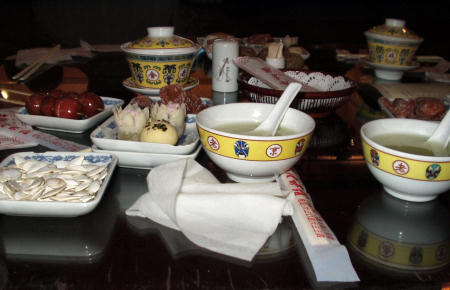
This is what they serve in the tea house, with all kinds of sweet things to
eat.
The above is one of my favourite pictures, Tian'anmen Square by night, almost
as if the buildings are on fire. Very beautiful.

The next day we went to the Great Wall. It’s about an hour’s drive
from Beijing. Of course the great wall is very long, as you might have heard,
and there are many sites you can visit. I went to one called Badaling, which
is northwest of the city.

This is the cable car which takes you up to the Wall itself.

I had read so much about the Great Wall, and since I was a child I had wanted
to see it, this great masterpiece of human construction which you can see from
Space. But I went there on a Sunday, and there were so many people there. In
some ways this made me feel a little disappointed, because for me for so many
years it had been something so inaccessible. I wanted to be the only person
there, defending China against the Mongolian troops.

In the end we reached a place where people rarely go, and there it was the
way I had imagined it. One could see how they had built it, the shape is beautiful
and fascinating.
Here I am, finally all by myself, with no human being anywhere close by, just
like I had imagined it in my childhood.

This is the entrance to a wildlife park which is very close to the Great Wall.
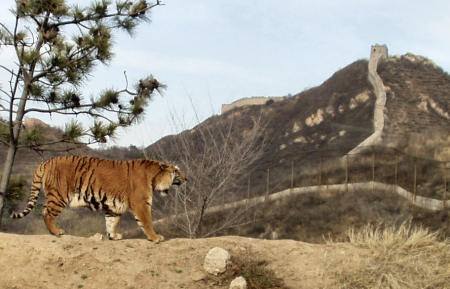
I love this picture. The tiger in the wildlife park was roaring, and in the
background there was the Great Wall. Very impressive.
This was a visitor and an ostrich, who looked like twins. The ostrich was
quite fascinated and kept plucking at his blazer. It was quite funny.
Two new friends I made in the wildlife park.
This is my Chinese panda. That is what I called Xie Jun, because she became
a very dear friend, and she likes to eat bamboo. What I realised during my
stay in China was that she loves her country very much, but the people love
her even more. She is very well known in China, people recognise her in the
streets, they say “Oh hello Xie Jun, how are you doing, we hope that
everything is fine with your life.”
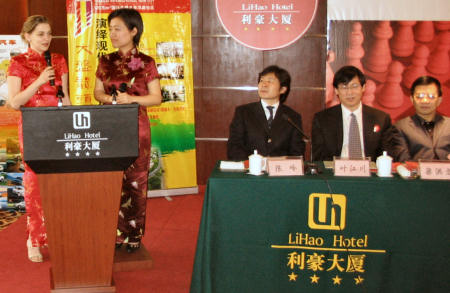
Xie Jun is always forcing me to give speeches. In the middle of a ceremony
she will say: “Two minutes,” which means that she is going to drag
me on the stage and make me speak to the audience. I think she likes to torture
me. But at least she is there with me, translating into Chinese. I finished
this speech saying I had to learn Chinese, just to find out if she is not saying
something completely different.
Xie Jun – a Chinese institution
Xiè Jūn ( 谢军 ) was born October 30, 1970 in Beijing, and
became junior Xiangqi (Chinese chess) champion of the city at the age of six.
She took up Western chess and in 1991 won the women's world championship for
the first time, beating the long-time champion Maya Chiburdanidze of Georgia
by a score of 8.5:6.5. In 1993 she defended her title against Nana Ioseliani,
also from Georgia, whom she beat 8.5:2.5.
In 1996 Xie Jun lost her title to Zsuzsa Polgar by a 4.5:8.5 score. But in
1999, after FIDE had stripped Polgar of her title, Xie won it for a second
time against Alisa Galliamova, whom she defeated 8.5:6.5. After FIDE changed
the format to a knock-out system in 2000, she won the title again, beating
her compatriot Qin Kanying in the final. In 2001/2002 the knock-out world championship
was won by Zhu Chen, who became the eleventh women's world champion at the
age of 25.

Best friends: Susan Polgar vs Xie Jun at the Chess Olympiad in Calviá
2004
Xie Jun is one of the main driving forces of Chinese women's chess. She is
responsible for Gold medals won at the 1998 Chess Olympiad in Elista, and more
recently in Calvia, where she had the second highest board one performance
(behind Susan Polgar). And this in spite of psychology studies and dedicated
work in organisational matters. These days Xie spends most of her time working
as an official in the Beijing Sport Commission, taking care of chess players
and other sports people. Sie is probably the most recognised and best loved
chess player in China today.
Links



















